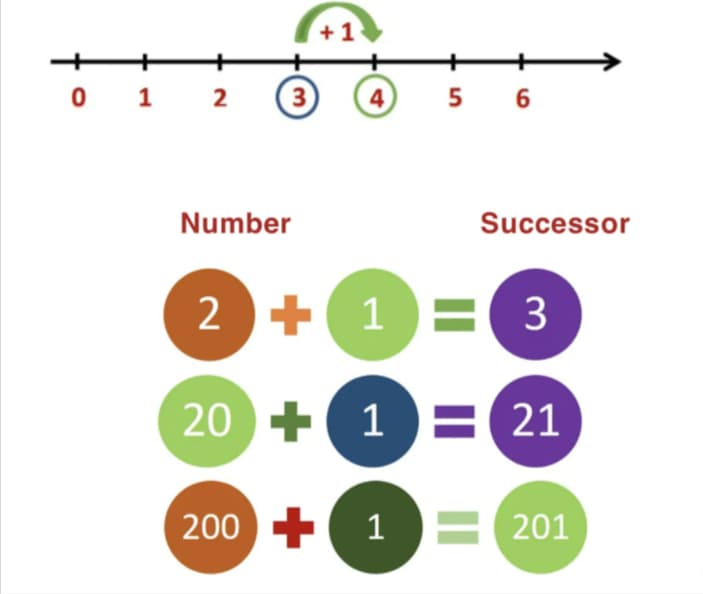Successor in mathematics is an operation that is similar to addition, but with a small difference. In normal addition operation, we add 2 numbers and so on. But in the successor operation, we will be adding or giving the next whole number value.
For example, the successor of the number 1 is 2, and 6 is 7 as we just need to add one number to the current value or the current number. Let’s dive deep into the sea of Successors.
An example of Successor is attached below

Table of contents
Why is Successor so Important in Maths?
The successor is important in mathematics because this is one of the operations which is associated with operations like Addition.
Successor denotes achievement, which implies a forward-thinking attitude.
The successor is defined by the position’s next step. Simply put, the next number is after the current number.
These successors are critical in statistics and number theory.

Understanding Successor
The word successor itself means a thing that comes after something. So it is the next step or the next level.
For example, suppose we’re playing a game and we reach level 4?
We will eventually reach level 5, with a slight increase in difficulty. Similarly, we keep adding one to the required or given number.
Birth of the Successor
In 1986, the successor model was proposed and research on hyperoperations began.
Addition, subtraction, multiplication, and division are the hyper operations. In an ideal world, the successor is the origin of all arithmetic operations.
Successor Formula
The general formula for the successor is S(n)= S(n+1).
The explanation of the above formula is as follows:
S(n) - - -> given natural number
S(n+1) - - -> adding 1 to the given natural number.
Working Example:
S(n)=7
S(n+1) = 8 (7+1)
A very simple formula to remember isn’t it?.
Yes, exactly! The successor concept has another name which is also known as Next-in-line.
Next-in-line, the word itself is easy to understand as the next consecutive number.
Let’s solve a few examples for Successor:
- Successor of 5 = 6(5+1)
- Successor of 99 = 100(99+1)
- Successor of 8999 = 9000(8999+1)
Suppose if we have negative numbers, for example, the successor for -8 is -7. The calculations are as follows.
S(n)= -8 S(n) = n+1 - - -> -8+1
The Final answer is -7.
The calculation is simple. Whatever number we have or we get, we need to apply as it is. The last answer is the correct answer. So simple isn’t it?
Tips to be noted down
- It is one of the important operations in Mathematics.
- It is related to Addition since it performs increments.
- The Successor has a very easy formula which is S(n)=S(n+1).
- In statistics, it is one of the important concepts for performing the operations.
- It is the origin of hyper operations like addition, subtraction, multiplication, and division.
- If we learn these successor operations, the next operation like the predecessor will be easy for us.
- This is also one of the important concepts in Number Theory.
Conclusion
As the term successor implies, it is a thing that follows or comes after something. Similarly, in mathematics, the successor defines the next whole number after the given number.
All we need to do is replace the ‘n’ in the formula with the given number to get the answer!
As we can see, the concept of the successor is one of the simplest operations in mathematics, yet it plays an important role in understanding more complex topics. Math classes for kids can help make this concept clear and accessible, providing a strong foundation for young learners to build on as they progress to more advanced mathematical concepts.
All we need to know is the formula and how to use it. Mathematics becomes more enjoyable if we just know the right formulae.
With the world moving at such a breakneck pace, BrightChamps recognized the need to introduce key life/future skills to children to keep them ahead of the game. BrightChamps offers Google coding for kids, introducing them to the exciting world of programming and computer science.
With a mission to bridge the gap left by traditional education, we are bringing key future skills through specially designed courses on coding and financial literacy taught by some of the world’s best minds from top-tier institutes such as IITs and IIMs.
















